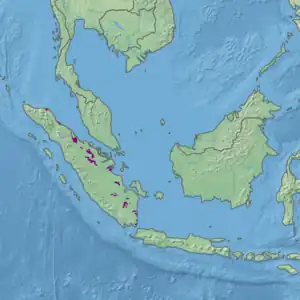| Sumatran freshwater swamp forests | |
|---|---|
 | |
 Ecoregion territory (in purple) | |
| Ecology | |
| Realm | Indomalayan |
| Biome | Tropical and subtropical moist broadleaf forests |
| Geography | |
| Area | 18,130 km2 (7,000 sq mi) |
| Country | Indonesia |
| Coordinates | 0°45′S 101°45′E / 0.75°S 101.75°E |
The Sumatran freshwater swamp forests ecoregion (WWF ID: IM0157) covers disconnected patches of freshwater swamp forest on the alluvial plains of the island of Sumatra in Indonesia. The different locations vary greatly in their vegetation and wildlife habitat depending on the local soil types. The land has been greatly disturbed by human conversion to agriculture and illegal logging in recent years. Several of the sectors support significant populations of Asian elephants (Elephas maximus)'.[1][2][3][4]
Location and description
The sectors of the ecoregion tend to be bounded on the south by Sumatran lowland rain forests, and on the northern side by Sumatran peat swamp forests. The freshwater swamps differ from the Peat swamp forest in having less waterlogged soil, more fertile soils, and more water derived from rivers and rainwater.[1] The freshwater swamps are all on low plains, with the maximum elevation in the ecoregion only 63 meters.[3]
Climate
The climate of the ecoregion is Tropical rainforest climate (Köppen climate classification (Af)). This climate is characterized as hot, humid, and having at least 60 mm of precipitation every month.[5][6]
Flora
Trees in swamps must be able to endure prolonged periods of inundation, and many species have developed buttresses, stilt roots, and pneumatophores (ariel roots with specialized respiratory structures). Common species of trees include Adina (a shrub/tree of the coffee family), Alstonia (large trees producing commercially valuable timber), Campnosperma (of the cashew family), Mallotus, the evergreen Dillenia, Dyera (which can grow to 80 meters in height), Coral tree (Erythrina), and the evergreen Eugenia.
Fauna
Mammals of conservation interest, aside from the Asian Elephants, include the endangered Malayan tapir (Tapirus indicus) (very few left as of 1997), and the endangered Sumatran tiger (Panthera tigris). The grasslands in the swamps provide important habitat for waterbirds.
Protected areas
Less than 4% of this ecoregion is officially protected. Notable protected areas include:
References
- 1 2 "Sumatran freshwater swamp forests". World Wildlife Federation. Retrieved March 21, 2020.
- ↑ "Map of Ecoregions 2017". Resolve, using WWF data. Retrieved September 14, 2019.
- 1 2 "Sumatran freshwater swamp forests". Digital Observatory for Protected Areas. Retrieved August 1, 2020.
- ↑ "Sumatran freshwater swamp forests". The Encyclopedia of Earth. Retrieved August 28, 2020.
- ↑ Kottek, M., J. Grieser, C. Beck, B. Rudolf, and F. Rubel, 2006. "World Map of Koppen-Geiger Climate Classification Updated" (PDF). Gebrüder Borntraeger 2006. Retrieved September 14, 2019.
{{cite web}}: CS1 maint: multiple names: authors list (link) CS1 maint: numeric names: authors list (link) - ↑ "Dataset - Koppen climate classifications". World Bank. Retrieved September 14, 2019.